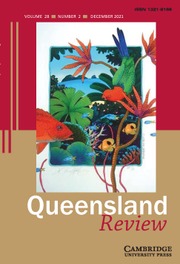Article contents
Aboriginal Trade in Fish and Seafoods to Settlers in Nineteenth-Century South-East Queensland: A Vibrant Industry?
Published online by Cambridge University Press: 30 October 2013
Extract
Aboriginal peoples have been ‘doing business’ with foreigners for centuries (McCarthy 1939; Langton, Mazel and Palmer 2006), yet research to date has focused either on traditional exchange networks (Donovan and Wall 2004) or the impact of Western goods. Thus Harrison (2002) and Jones (2007) plotted Aboriginal exchange values and redistribution systems for iron and cloth. The general impression from such works is that, following European contact, Aboriginal society was radically transformed, while Europeans received curios. For example, Western goods stimulated a ‘glass artefact industry’ (Harrison 2003) and Aboriginal ‘doggers’ controlled dingos (Young 2010), but only officials or anthropologists had use for the resultant spearheads and scalps. At best, Aboriginal–European trade is considered inconsequential — ‘trinkets for trash’ — while Noel Butlin's (1994) analysis of the colonial economy entirely ignores it. Discussion of profitable exchange seems limited to the post-1950s arts trade (Kleinert 2010: 175). The notion that Aboriginal people might ‘flourish’ in trade or labour with Europeans (e.g. Anderson 1983) is discarded as absurd (White 2011: 81). This is perplexing, because colonial expansion saw commercial exchanges with Indigenous peoples all over the globe. Trade between Europeans and native people forms the opening chapter of national histories — for example, those of Canada and New Zealand (Innis 1999; Salmond 1997; McLusker 2006).
- Type
- Articles
- Information
- Copyright
- Copyright © Cambridge University Press 2013
References
- 8
- Cited by


